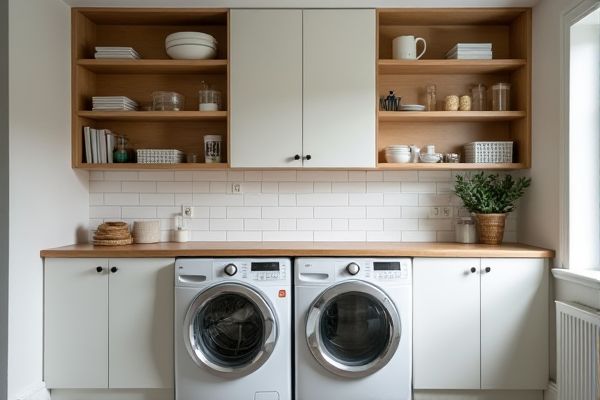
Open shelving in laundry rooms offers easy access and visibility for frequently used items, while closed cabinets provide a cleaner look and protect supplies from dust and moisture. Discover which storage solution best suits Your laundry space and organizational needs by reading the rest of this article.
Table of Comparison
| Feature | Open Shelving Laundry | Closed Cabinets Laundry |
|---|---|---|
| Accessibility | Easy access to laundry essentials | Requires opening doors to access items |
| Storage Capacity | Limited organization options | Maximized storage with shelves and compartments |
| Visibility | Items always visible for quick retrieval | Items hidden, creating a clean look |
| Maintenance | Dust accumulates easily, frequent cleaning needed | Protects items from dust and clutter |
| Design Style | Casual, airy, modern aesthetics | Traditional, sleek, polished appearance |
| Cost | Generally more affordable | Higher cost due to materials and installation |
| Customization | Limited customization options | Highly customizable with adjustable shelves and doors |
Introduction to Open Shelving vs Closed Cabinets
Open shelving in laundry rooms offers easy access and visibility, promoting quick organization and efficient use of space. Closed cabinets provide a cleaner, more streamlined look by concealing laundry supplies and reducing dust accumulation. Choosing between open shelves and closed cabinetry depends on preferences for aesthetic appeal, accessibility, and maintenance requirements in laundry room design.
Aesthetic Appeal: Modern vs Traditional Looks
Open shelving in laundry rooms creates a modern, airy aesthetic that highlights minimalism and easy access to essentials, often featuring sleek metal or wooden brackets. Closed cabinets offer a traditional look with clean lines and concealed storage, providing a tidy and organized appearance that complements classic or farmhouse-style interiors. Choosing between these options depends on desired visual impact and functional preferences in laundry room design.
Space Optimization and Storage Capacity
Open shelving in laundry rooms maximizes vertical space, allowing easy access to frequently used items while visually expanding the room. Closed cabinets offer superior storage capacity by concealing clutter and protecting supplies from dust and moisture, making them ideal for organizing bulkier or less attractive items. Combining both solutions can optimize space by balancing accessible storage with hidden organization and maintaining a clean, efficient laundry area.
Accessibility and Convenience
Open shelving in laundry rooms offers immediate accessibility, allowing easy reach of frequently used items like detergents and fabric softeners without opening doors. Closed cabinets protect supplies from dust and moisture, keeping the space organized and visually clutter-free while providing concealed storage for less frequently used products. Both options enhance convenience depending on user preference for visibility and protection.
Organization and Clutter Control
Open shelving in laundry rooms allows easy access and visibility, making it simpler to organize frequently used items like detergents and cleaning supplies, but it may require consistent tidiness to prevent clutter. Closed cabinets offer superior clutter control by concealing items, creating a cleaner and more streamlined appearance while protecting contents from dust and moisture. Your choice depends on whether you prioritize quick accessibility or a more polished, organized look in your laundry space.
Maintenance and Cleaning Requirements
Open shelving in laundry rooms requires frequent dusting and careful organization to prevent dirt and detergent residue buildup, while closed cabinets provide better protection from moisture and dust, reducing the need for constant cleaning. Closed cabinets often feature smooth, wipeable surfaces that make maintenance quicker and more efficient, helping to keep laundry supplies clean and organized. Choosing closed cabinets enhances overall cleanliness and minimizes maintenance efforts compared to open shelving.
Durability and Longevity
Closed cabinets in laundry rooms generally offer superior durability and longevity compared to open shelving due to their solid construction and protective doors that shield contents from moisture and dust. High-quality materials like solid wood or metal in closed cabinets can withstand frequent exposure to humidity and temperature changes typical in laundry areas. You can extend the lifespan of your storage by choosing sealed, water-resistant finishes that maintain structural integrity over time.
Cost Comparison: Budget Considerations
Open shelving in laundry rooms typically costs less than closed cabinets due to reduced material and installation expenses, making it a budget-friendly option for homeowners. Closed cabinets, while more expensive upfront, offer enhanced protection for laundry essentials from dust and moisture, potentially reducing long-term replacement costs. Evaluating initial costs alongside durability and maintenance expenses helps determine the most cost-effective storage solution for specific laundry room needs.
Customization and Design Flexibility
Open shelving offers unparalleled customization and design flexibility in laundry spaces by allowing you to mix and match baskets, hooks, and containers for a personalized organization system. Closed cabinets provide concealed storage that can be tailored with adjustable shelves, built-in hampers, and pull-out drawers to optimize space and maintain a clutter-free appearance. Choosing between the two depends on your preference for easy access and visual openness versus streamlined design and hidden storage.
Best Choice: Factors to Consider for Your Laundry Room
Open shelving in your laundry room offers easy access and visibility for frequently used items, making organization straightforward but requires regular tidiness to maintain a clean look. Closed cabinets provide concealed storage, protecting supplies from dust and enhancing a sleek, clutter-free appearance, ideal for smaller or multifunctional spaces. Consider factors like available space, cleaning habits, and aesthetic preferences to decide whether visibility or concealment best suits your laundry room needs.
 homyna.com
homyna.com